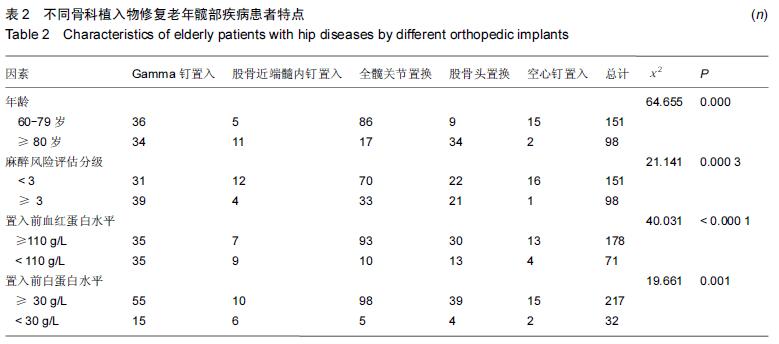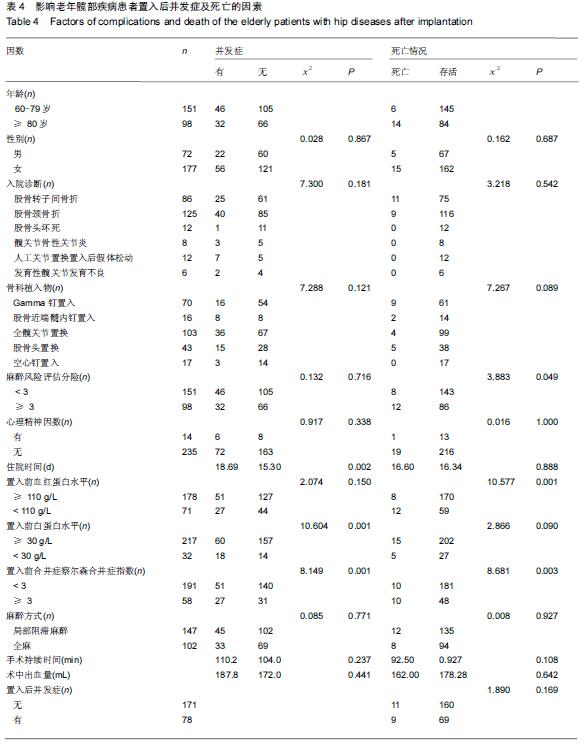| [1] Genant HK, Cooper C, Poor G, et al. Interim report and recommendations of the World Health Organization Task-Force for Osteoporosis. Osteoporos Int. 1999;10(4): 259-264. [2] 李子荣.科学诊断和治疗股骨头坏死[J].中国修复重建外科杂志,2005,19(9):685-686. [3] 刘林英.股骨头坏死分析[J].中国疗养医学,2007, 16(7):447. [4] Chamberlain JR, Schwarze U, Wang PR, et al. Gene targeting in stem cells from individuals with osteogenesis imperfecta. Science. 2004;303(5661):1198-1201. [5] 赵东风,刘欣伟,岳勇.全髋关节置换术治疗成人先天性髋关节发育不良伴股骨头坏死中期随访疗效观察[J].中国骨与关节损伤杂志,2012,27(2):132-133. [6] 王振恒,方永超,阚翔翔,等.影响老年髋部骨折患者术后1年死亡率的因素分析[J].中国矫形外科杂志,2014,22(2): 110-114. [7] Carpintero P, Caeiro JR, Carpintero R, et al. Complications of hip fractures: A review. World J Orthop. 2014;5(4):402-411. [8] Bell JJ, Pulle RC, Crouch AM, et al. Impact of malnutrition on 12-month mortality following acute hip fracture. ANZ J Surg. 2016. in press. [9] Frihagen F. On the diagnosis and treatment of femoral neck fractures. Acta Orthop Suppl. 2009; 80(335):1-26. [10] 冯胜凯.老年股骨转子间骨折PFNA固定与人工股骨头置换疗效比较[D].郑州:郑州大学,2014. [11] 李子荣.股骨头坏死临床诊疗规范(2015年版)[J].中华关节外科杂志(电子版),2015,(1):133-138. [12] 中华医学会骨科学分会.骨关节炎诊治指南(2007年版)[J].中国矫形外科杂志,2014,22(3):287-288. [13] Kotlarsky P, Haber R, Bialik V, et al. Developmental dysplasia of the hip: What has changed in the last 20 years? World J Orthop. 2015;6(11):886-901. [14] 林梁.发育性髋关节发育不良的外科治疗[D].福州:福建医科大学,2012. [15] 杨庆铭.全髋关节置换术后的假体松动[J].中华关节外科杂志(电子版),2009,3(5):635-638. [16] Charlson ME, Pompei P, Ales KL, et al. A new method of classifying prognostic comorbidity in longitudinal studies: development and validation. J Chronic Dis. 1987;40(5):373-383. [17] Charlson M, Szatrowski TP, Peterson J, et al. Validation of a combined comorbidity index. J Clin Epidemiol. 1994;47(11):1245-1251. [18] Memtsoudis SG, Pumberger M, Ma Y, et al. Epidemiology and risk factors for perioperative mortality after total hip and knee arthroplasty. J Orthop Res. 2012;30(11):1811-1821. [19] A C U, E W, B K, et al. Treatment of trochanteric fractures with the gamma3 nail-methodology and early results of a prospective consecutive monitored clinical case series. Open Orthop J. 2014;8:466-473. [20] Manohara R, Liang S, Huang D, et al. Cancellous screw fixation for undisplaced femoral neck fractures in the elderly. J Orthop Surg (Hong Kong). 2014;22(3):282-286. [21] Geiger F, Zimmermann-Stenzel M, Heisel C, et al. Trochanteric fractures in the elderly: the influence of primary hip arthroplasty on 1-year mortality. Arch Orthop Trauma Surg. 2007;127(10):959-966. [22] Antapur P, Mahomed N, Gandhi R. Fractures in the elderly: when is hip replacement a necessity? Clin Interv Aging. 2011;6:1-7. [23] White BL, Fisher WD, Laurin CA. Rate of mortality for elderly patients after fracture of the hip in the 1980's. J Bone Joint Surg Am. 1987;69(9):1335-1340. [24] Hu F, Jiang C, Shen J, et al. Preoperative predictors for mortality following hip fracture surgery: a systematic review and meta-analysis. Injury. 2012;43(6):676-685. [25] Lim YW, Kwon SY, Han SK, et al. Postoperative mortality and factors related to mortality after bipolar hemiarthroplasty in patients with femoral neck fractures. J Arthroplasty. 2009;24(8):1277-1280. [26] Gulin T, Kruljac I, Kirigin L, et al. Advanced Age, High β-CTX Levels, and Impaired Renal Function are Independent Risk Factors for All-Cause One-Year Mortality in Hip Fracture Patients. Calcif Tissue Int. 2016;98(1):67-75. [27] Söderqvist A, Ekström W, Ponzer S, et al. Prediction of mortality in elderly patients with hip fractures: a two-year prospective study of 1,944 patients. Gerontology. 2009;55(5):496-504. [28] Norring-Agerskov D, Laulund AS, Lauritzen JB, et al. Metaanalysis of risk factors for mortality in patients with hip fracture. Dan Med J. 2013;60(8):A4675. [29] Roche JJ, Wenn RT, Sahota O, et al. Effect of comorbidities and postoperative complications on mortality after hip fracture in elderly people: prospective observational cohort study. BMJ. 2005;331(7529):1374. [30] Wang HY, Chew G, Kung CT, et al. The use of Charlson comorbidity index for patients revisiting the emergency department within 72 hours. Chang Gung Med J. 2007;30(5):437-444. [31] Kondo A, Zierler BK, Isokawa Y, et al. Comparison of lengths of hospital stay after surgery and mortality in elderly hip fracture patients between Japan and the United States - the relationship between the lengths of hospital stay after surgery and mortality. Disabil Rehabil. 2010;32(10):826-835. [32] Marín LA, Salido JA, López A, et al. Preoperative nutritional evaluation as a prognostic tool for wound healing. Acta Orthop Scand. 2002;73(1):2-5. [33] 黄武君,裘曙文,何勇,等.营养不良对老年股骨粗隆间骨折手术切口的影响[J].现代实用医学,2015,27(7): 943-944. [34] Lee HP, Chang YY, Jean YH, et al. Importance of serum albumin level in the preoperative tests conducted in elderly patients with hip fracture. Injury. 2009;40(7):756-759. [35] Pioli G, Barone A, Giusti A, et al. Predictors of mortality after hip fracture: results from 1-year follow-up. Aging Clin Exp Res. 2006;18(5):381-387. [36] 贾学宽,孙天胜.血液指标对老年髋部骨折死亡率预测研究进展[J].实用骨科杂志,2015,(12):1093-1095. [37] Miyanishi K, Jingushi S, Torisu T. et al. Mortality after hip fracture in Japan: the role of nutritional status. J Orthop Surg (Hong Kong). 2010;18(3):265-270. [38] 吕鹏,叶劲,张琳,等.112例老年髋部手术的围手术期风险预测和临床分析[J].中国中医骨伤科杂志,2010,(5): 33-34. [39] Kovar FM, Endler G, Wagner OF, et al. Basal haemoglobin levels as prognostic factor for early death in elderly patients with a hip fracture--A twenty year observation study. Injury. 2015;46(6):1018-1022. [40] 纪木强,熊昌盛,翁天才,等.血清白蛋白?血红蛋白水平和淋巴细胞计数对老年髋部骨折手术患者预后的影响[J].中国骨科临床与基础研究杂志,2014,(3):144-148. |
.jpg)





.jpg)
.jpg)